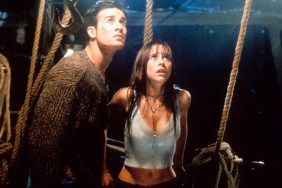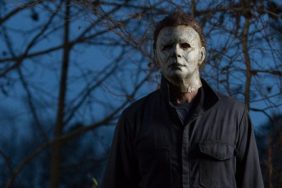Starring Bridget Fonda and Jennifer Jason Leigh

No one trick or treats on the last day of school, no one carves jack o’ lanterns on July 4th, or goes on haunted hayrides in August.
When it comes to beloved macabre traditions, the fall is the season that gets all the attention. Thanks to the celebration of Halloween, the autumn months have always been indelibly associated with all things frightful. Summer, on the other hand, is ostensibly all that horror isn’t about â a golden time of warm weather, trips to the beach, fireworks, road trips and family picnics.
For those movie buffs that prefer the inside of their neighborhood cinemas (or, for some, the nighttime chill of drive-in theaters) to the blistering heat, however, the summer is the real witching season. Some believe that horror vacations in summer, waiting for fall to arrive, but box office history tells a different story.
Starting in 1975 when Jaws invented the modern blockbuster by teaching a generation to be afraid of the ocean, summer has been the best time of year to be scared. The fall can keep Halloween. It can keep the costumes, the candy, the Great Pumpkin, all of it â because summer has always had the better movies.

In the early ’90s, slashers weren’t stalking high school proms anymore. Or co-ed dorms. Or slumber parties. Instead of the usual assortment of stoned, sex-crazed teenagers or vulnerable babysitters being sliced and diced, it was now polished young professionals with hot careers who were doing all the dying.
Coming off the prosperity of the ’80s, the early ’90s was the era of the yuppie slasher movie. These were the “_________ from Hell” movies. There was the landlord from Hell (Pacific Heights, 1990); the ex-husband from Hell (Sleeping with the Enemy, 1991); the nanny from Hell (The Hand That Rocks The Cradle, 1992); the jailbait from Hell (Poison Ivy, 1992); the cop from Hell (Unlawful Entry, 1992); the girl-next-door from Hell (The Crush, 1993), and the intern from Hell (The Temp, 1993). If the early ’80s slasher boom had seen filmmakers mining the calendar for every available holiday and social event to turn into a blood bath, the early ’90s had them searching for every possible type of person who might play a part in our everyday lives and make them into hell-spawned psychos.
Horror fans did not embrace these mainstream-minded movies in general but I loved them. They did what horror films are supposed to do (and what “straight” horror films had perplexingly stopped doing at that time) â put the audience on the edge of their seats. Even Martin Scorsese had his own entry in this trend with the ex-con from Hell in his Cape Fear remake, a film that in 1992 happened to fit right in to where the horror/thriller genre was at then. Even though these movies were scare machines, everyone connected with them actively tried to dodge the “horror” label. These were the big horror movies at the time but yet you could rarely read about them in the pages of Fangoria. Anyone who read Fango back then remembers that the magazine was forced to create a new column called “It’s Not A Horror Film,” specifically as a means to cover these “upscale thrillers” that filmmakers and studios didn’t want to be regarded as horror. All protests to the contrary, though, that’s what they were. While the fad lasted, they offered trashy fun and filled a huge void for scary cinema. Granted, they were still much classier than, say, Prom Night or The Burning but their true colors were apparent to audiences. One of the highpoints of the yuppie slasher sub-genre was Single White Female, released in August of 1992. The question posed by Single White Female‘s trailer perfectly summed up the early ’90s slasher cycle: “How do you lock the terror out when you already invited it in?”

Based on John Lutz’s 1990 novel “SWF Seek Same, Single White Female” stars Bridget Fonda as Allison Jones, a young Manhattanite with her own software design business. She lives in an enviable apartment on the Upper West Side, which she shares with her boyfriend Sam Rawson (Steven Weber). In the opening moments of the film, Allie’s perfect world is turned upside down when she discovers Sam’s infidelity. After angrily jettisoning Sam from her life and her apartment, Allie is faced with the challenge of paying the rent alone. An ad for a roommate leads to many eager candidates for Allie to interview and just when she thinks she’s settled on the ideal candidate, an inquiring Hedra Carlson (Jennifer Jason Leigh) walks into the apartment to find Allie sobbing over her break-up with Sam.
Hedra (“Hedy” for short) immediately strikes a rapport with Allie and before the end of their visit; Hedy has beaten all contenders to win the coveted spot of Allie’s new roomie. Hedy expresses her concern that Allie might patch things up with Sam, a development that would leave Hedy high and dry, but Allie assures her that any reconciliation between the former lovers won’t be happening. Once Hedy moves in, life is sweet between her and Allie at first. But unlike other famous female duos such as Cagney and Lacey, Kate and Allie, and Thelma and Louise, one half of this new friendship is insane. Hedy is not just the shy, needy type she appears to be. She’s a shy, needy type with nuclear-level anger issues, a loose grip on reality, and is as attached to Allie as tightly as an alien face-hugger. Anyone who tries to separate her from her new BFF is likely to become DOA.
Things take awhile to unravel. At first, the signs that Allie should be afraid, very afraid, of her roommate are imperceptible. For example, when Hedy brings a dog home without asking Allie for permission first, it seems innocent enough â except for the fact that Hedy lies to Allie about that fact that she purposely bought the dog (instead she tells Allie that it was a stray being given away). It isn’t until Sam comes back into the picture and convinces Allie to give their relationship another chance that Hedy’s back gets pushed to the wall. And when push comes to shove, you’d be surprised how hard this tiny girl can shove back â and how hard she can swing a stiletto-heeled shoe. As a physical threat, Hedy may not invincible but as Allie discovers, she’s almost impossible to shake loose.

This film was the big shocker of the summer of ’92; really, the only shocker. Alien3 has been belatedly appreciated but at the time of its release it had left most disappointed; Brian DePalma’s much-anticipated return to suspense with Raising Cain seemed like a hollow send-up of his previous work; Pet Sematary II was one of the more useless sequels ever committed to film; and Twin Peaks: Fire Walk With Me was brilliant but confounding and strictly for the TV show’s hardcore fanbase. Unlawful Entry had been an effective nail-biter early in the summer but Single White Female was the real attraction. If you wanted a good scare in the summer of ’92, this was the movie to see.
Jennifer Jason Leigh gives a memorable performance as the deranged but not despicable Hedy, always keeping Hedy’s seething insecurities close to the surface. This is not an evil character (although she does do more than her share of evil things); she’s just a person so empty that she’ll do anything to keep Allie in her life. Failing that, she’ll usurp Allie’s life, with the film’s most unforgettable scene being the moment at the beauty salon when Hedy shows off her new, identical-to-Allie’s haircut â an “oh, shit!” moment if there ever was one. It’s not just the bodily harm that Hedy is capable of inflicting that makes her scary. It’s the implication that this invisible person could effortlessly hijack Allie’s identity. Bridget Fonda may have the far less showy role here but she makes for an appealing protagonist â even if Allie’s decision-making skills could use some work.
Director Barbet Schroeder was best known at the time for Oscar fare like Reversal of Fortune (1990) and while this project was a clear bid to score a commercial success, thanks in great part to the talents of Fonda and Leigh, Single White Female had artistic merit as well. For Schroeder, Fonda, and Leigh, this movie stands as a collective peak in their careers. Married to composer Danny Elfman since 2003, Fonda’s last acting credit to date is the 2002 TV movie Snow Queen. And while Jennifer Jason Leigh continues to keep busy in such acclaimed projects as Margot at the Wedding (2007), and Synecdoche, New York (2008), Hedy remains the role that she’s most associated with. Schroeder, too, never regained the same popular audience with his most recent work being for the AMC series Mad Men.

Coming between the Golden Age of slashers and the post-ironic Scream-era, the yuppie slasher trend remains curiously underappreciated by horror fans. While these films might have been glossy and light on splatter, this was a terror trend that played an essential part in getting the genre back on track in the ’90s, pulling it back from the cartoonishness of the late ’80s. These films didn’t serve up half-baked scares with one-liners, they weren’t tongue-in-cheek; instead they were sincere about suspense and got audiences clutching their seats and yelling out to the characters on screen in classic horror movie fashion.
Films like Single White Female will never be the fan favorites that old-school slashers like My Bloody Valentine and The Prowler are (even if the phrase “single white female” itself has become a part of the cultural lexicon). They’ll never be the subjects of Fright-Rags T-shirts. But in their day, these tales of insidious intruders kept horror fans in good company.
Alien3 (May 22nd)
Unlawful Entry (June 26th)
Buffy the Vampire Slayer (July 31st)
Death Becomes Her (July 31st)
Raising Cain (August 7th)
Pet Sematary II (August 28th)
Twin Peaks: Fire Walk With Me (August 28th)
The Amityville Horror (Jeff Allard)
Phantasm (Ryan Turek)
SUMMER OF 1980:
Friday the 13th (Jeff Allard)
SUMMER OF 1981:
Deadly Blessing (Jeff Allard)
Wolfen (Ryan Turek)
SUMMER OF 1982:
Poltergeist (Jeff Allard)
Friday the 13th: Part 3 (Ryan Turek)
SUMMER OF 1983:
Psycho II (Jeff Allard)
SUMMER OF 1984:
Dreamscape (Jeff Allard)
SUMMER OF 1985:
Day of the Dead (Jeff Allard)
SUMMER OF 1986:
The Fly (Jeff Allard)
SUMMER OF 1987:
SUMMER OF 1988:
SUMMER OF 1989:
Friday the 13th Part VIII: Jason Takes Manhattan
SUMMER OF 1990:
Class of 1999
SUMMER OF 1991:
Body Parts





Source: Jeff Allard









